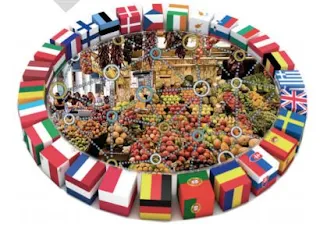Online Use of Languages in the EU: Customers Are Six Times More Likely to Buy From Sites in Their Native Language.
Current research* on the online use of languages in the EU demonstrates
that there is increasing pressure to overcome language barriers. Online content
in hitherto dominant languages is declining and “long-tail” languages are
rising.**
In line with the constant rise of online content, absolute
numbers are rising for all languages, and much more significantly so for less
common languages. One example in Europe: Basque, Galician, and Catalan all have
an increasing share vis-a-vis Spanish; even though the numbers are small, they
indicate a long-term shift.
Customers are six times more likely to buy from sites in
their native language. Most EU languages address less than 3% of the market,
fundamentally limiting SMEs operating in countries where those languages are
spoken. English is not the answer. 52% of EU customers do not purchase from
English-language sites.
Adding even a few languages to an SME’s website beyond
English can have a major impact on revenue. Large organizations today often localize
products and websites into 50 or more languages to increase market share.
This trend goes hand in hand with increasing public demand
for content in regional or local languages due to the increasing availability
of broadband as well as high speed mobile connectivity and rising numbers of
online users and online services. Europe’s citizens are no longer satisfied
with using only a few major languages.
As a consequence, businesses that cannot provide content in
local languages will be global losers. Furthermore, the numbers indicate that
market saturation for dominant languages has been reached and that any
additional growth is coming from outside the established markets, historically
served by a smaller set of languages***
If we extrapolate the
trends reported by Common Sense Advisory, it only took 37 languages to reach
98% of the world online population in 2009, but already 48 in 2012. The predicted
number in 2015 is 62 languages. More and more citizens are connected and, as a
consequence, more and more citizens use – and expect to use – their
own native languages in any online activities. However, they are excluded from
participating in many online activities due to the fact that language barriers
constitute market barriers – especially so with regard to the DSM (Digital
Single Market). True engagement with consumers across language barriers is also
deeply entwined with the user’s technical, cultural, and individual awareness,
preferences, and requirements. The power of personalizing any cross-linguistic
exchange to an individual user means we should not merely bridge the language
barrier but provide the kind of compelling personalized user experience that is
key to a vibrant and competitive DSM.
As Europeans, we urgently need to ask ourselves some crucial
questions: Can Europe afford continued language-blocking, market fragmentation
caused by language borders, language discrimination, and, eventually, digital
language extinction?
Can we afford to have our information, communication and
knowledge infrastructure depend so much on monopolistic services provided by
foreign, non-European companies, effectively constituting technological
lock-in?
What is Europe’s fallback plan in case the language-related services
provided by non-European companies that we rely upon are suddenly switched off
or if even more serious access or security issues arise?
Is Europe actively
making an effort to compete in the global landscape for research and
development in language technology?
Can we expect third parties from other
continents to solve our translation and knowledge management problems in a way
that suits our specific communicative, societal and cultural needs?
Language
Technology made for Europe in Europe will significantly contribute to future
European crossborder and cross-language communication, economic growth and
social stability while establishing for Europe a leading global position in
technology innovation, securing Europe’s future as a world-wide trader and
exporter of goods, services and information. Only a large, coordinated push of
this magnitude will be able to unlock a truly multilingual Digital Single
Market.
**Common Sense Advisory (2013): “The Rise of Long-Tail
Languages”.
*** “Traditional ‘power house’ languages are seeing some of
the biggest drops in overall site support: e.g. German: –11.7%, French: –13.4%,
Spanish –14.4%, i.e. a smaller percentage of ‘global’ sites are supporting
these languages, even as the number supporting long-tail languages is
increasing.” (ibid.)
*Source: Strategic Agenda for the Multilingual Digital SingleMarket. Technologies for Overcoming Language Barriers towards a truly integrated European Online Market.




Comments
Post a Comment